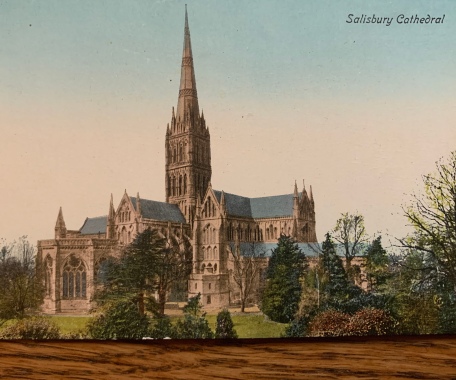
May breaks, with a complex sky and high procession of clouds. Earth is mobile, mercurial – mirroring the heavens, like the cold sun of each spent dandelion. Simone Weil, a writer whose lightning insights smoulder still, considered this counterpoint to be more than merely material:
‘Every human being has at their roots here below a certain terrestrial poetry, a reflection of the heavenly glory, the link, of which they are more or less vaguely conscious, with their universal country’
That our shifting, temporal existence might be partnered in a dance with eternity is an idea old as wisdom, and has choreographed the Christian understanding of space and time. Our ‘terrestrial poetry’ finds pinpoint places that map this instinct, requiring ‘you are here’ arrows, to indicate the way. Even the most outlandish scriptural depictions of the next world are necessarily rooted in this one (St John’s apocalyptic monsters still have wings and eyes, even if uncannily numerous) – the biblical heaven, in other words, is an extrapolation of the biblical earth.
A church spire is thus an upended map pin: a stake in empyrean fields, as if our mortal tent will swiftly blow away. In a week when many were to gather for the 800th anniversary of Salisbury Cathedral’s foundation, this is much in mind. I am carried back to a service there on this date last year, for the installation of new honorary canons – an event as ethereal as any I can recall. The atmosphere inside was seraphic, as we wafted on soft voluntaries to the prebendary stalls of Alton Borealis and Netherbury in Terra. My initial response was entirely to these radiant names: imagined and alternative versions of ordinary diocesan villages. Where on earth are these places? Viewed one way, this was obscure ceremonial with fairly worldly roots: prebends had been valuable endowments of land or other revenue attached to the office of cathedral canon and thereby prone to becoming the ecclesiastical equivalent of rotten boroughs. Yet the effect of invoking them was tremendous and, by the conclusion of worship, I felt as if we had visited another dimension, in which familiar parishes each had their celestial counterpart. Wherever Alton Borealis is, I felt, I want to dwell there.
From Martinsell – Iron Age hillfort and one of the loftiest, as well as most peaceful spots in Wiltshire – you can, on a clear day, see across Salisbury Plain to where the foremost spire in England lances the skies, glorifying God in the highest. It remains a kind of eternal trig pillar for pilgrims, including Thomas Fuller: an army chaplain from the English Civil War (‘A good Church of England man, with his heart in heaven and both feet on the ground’, according to Canon Charles Smyth). In his memoir of those stricken years, Mixt Contemplations, he reflects:
“Travelling on the plain (which notwithstanding hath its risings and fallings) I discovered Salisbury steeple many miles off; coming to a declivity, I lost sight thereof; but climbing up on the next hill, the steeple grew out of the ground again. Yea, I often found it and lost it, till at last I came safely to it, and took my lodging near it. It fareth thus with us whilst we are wayfaring to heaven. Mounted on the Pisgah top of some good meditation, we get a glimpse of our celestial Canaan; but when on the flat of an ordinary temper, or in the fall of an extraordinary temptation, we lose the view thereof. Thus, in the sight of our souls, heaven is discovered, covered, and recovered; till – though late, at last – though slowly, surely – we arrive at the haven of our happiness.”


What wonderful conceits you come up with. The spire as map pin; tent peg; trig pillar. I wonder if Canon Smyth’s lodging was at the New Inn, built 1380 – so the juvenile, fifty years younger than the spire.
Thank you! Yes, it might well have been the New Inn.